Third
Africa Page
14 April 1998
Today we drove the length of the West
Coast of South Africa, from the Fish River Canyon in Namibia to Capetown . . . about 850
kilometers. The terrain changed dramatically after we crossed the Orange River: from
mostly dry desert and mopane scrub to lush, green, rolling hill country heavily cultivated
with citrus and avocado orchards.
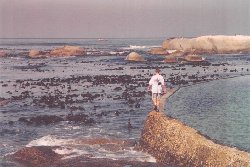 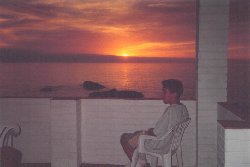
|
We'd reserved an apartment on the upper floor of an
oceanfront home in Llandudno, an isolated little suburb 15 km's south of downtown. Ten
km's north of Capetown we were met by our proprietor, Ian McPherson, and he guided us
through the city to his home. As we rounded out of the city, skirting the vertical
escarpment of Table Mountain on the left and the rugged Atlantic coastline on the right,
it became obvious why many people say that Capetown is one of the most spectacularly
situated cities in the world. The giant rocks and crashing surf at Llandudno reminds one
of a wilder version of the coastline around Monterey and Pacific Grove. |
15 April 1998
Kaaren and Ty spent the morning walking
through the beautiful Kirstenbosch Gardens on the eastern slope of Table Mountain. Dan
went into the city to shop for a local internet provider. Lunch at Fisherman's Wharf in
Hout Bay.
16 April 1998
| Drove through the national park at Cape Point, the
southernmost tip of Africa where Indian and Atlantic Oceans meet. Ostrich and Eland
(largest of all antelope) graze the scrub on the hillsides, and obnoxious baboons
terrorize the tourists. |
 |
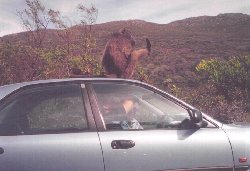 |
People kept taking pictures of our car and we
wondered why until somebody yelled to us that a baboon was eating our antenna. We tried
driving away but he just rode atop the roof, stomping and scratching and screaming at us
for a handout (Ganz verboten!). Only after we'd driven several hundred meters did he give
up and jump off, still cursing at us. |
| That evening we drove to a waterfront restaurant in
Capetown to have dinner with the dearest people we met in South Africa: Gielie, Elsabe,
and Erika Swart. We'd first met them at the Kuruman Mission weeks earlier. Then, several
days later and 1000 kilometers distant, by sheer happenstance we ended up in adjacent
rondavels at Okaukuejo Camp in Etosha. The whole Swart family are avid birders and spend
most holidays cruising Southern Africa in their safari wagon searching out new species. At
Okaukuejo Ty and Erika quickly struck up a friendship and spent hours walking and talking
and looking for birds and animals down at the waterhole. |
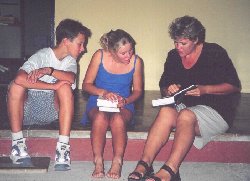 |
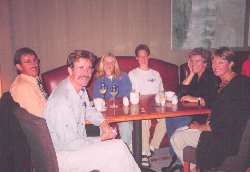 |
They asked us to call when we got to Capetown. Over
dinner we looked at maps and charted out an idyllic safari through Namibia, Botswana, and
Zimbabwe that we'd like to do together someday. Where Gielie wants to go is very wild
country and would be safer done with two vehicles, and he thinks we'd make a great troop.
After his two girls, then birds, Gielie's next love in life is fine wine. He presented us
with a box containing a selection of half a dozen bottles of his favorite vintages. |
17 April 1998
Said goodbye to the Ian McPherson and
started driving eastward along the beautiful southern coast, known as the Garden Route.
Before reaching the coast though, along both sides of the highway are hundreds of acres of
shantytowns. Many of those who live in the pathetic little hovels made of cardboard and
tin are illegal immigrants from northern countries attracted to the southern cape by the
slim hope of finding work in a country already desperately trying to generate jobs for
millions of unemployed. Basic services in the shantytowns are minimal and anarchy
prevails.
Further east the land becomes lush and
green; lots of grape and citrus cultivation. We rented a little bungalow at Tsitsikama
Lodge for the night and Ty found a several new birds there. Experienced a novel
meteorological phenomenon. It was cool and humid when we went to bed, but when we woke at
dawn a tremendous wind was blowing, hard enough that it was difficult to walk against. The
extraordinary thing was the heat of the wind . . . so hot and dry that in just moments
eyes and lips were parched.
18 April 1998
Eastward along the coast to Port
Elizabeth, and then north to Addo Elephant Park. This reserve was set aside to protect the
last of the great southern elephant herds. Lots of elephants, including frolicking tiny
babies. Black rhinos at the waterhole.
The biggest species of dung beetle
lives here. The ball of elephant poo this one is rolling across the road was about the
size of a baseball. |
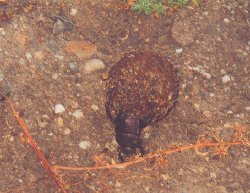 |
19 April 1998
Addo to Bloemfentein. We stayed at the
inexpensive and very comfortable Dias Guesthouse run by Rhyno and Mariette Kreik.
Unfortunately, even in this clean and prosperous town there is a sense of being under
siege, with security systems and bars on every window and door. On billboards and in all
the media we see evidence of a countrywide campaign underway to promote respect for law
and order, especially among youth.
20 April 1998
Bloemfentein to Pilanesberg National
Park. Stopped by Sun City (South Africa's Las Vegas) on the way, but when they asked for
R120 just to enter the place we drove on. Great accommodations inside Pilanesburg. Ty went
on an evening game drive. Plenty of zebra, warthog, antelope species (including first
Bushbuck).
21 April 1998
 |
We are the first ones out the camp gates for a game
drive when they opened at 0600. It's a beautiful, lusher park than we've seen
heretofore. Game is plentiful: all antelope species including eland, waterbuck, bushbuck,
kudu, plus hippos, rhinos, warthogs, giraffes, and lots of birds. About 0730 we stopped at
a wide spot with a good view to have our breakfast of biltong and granola (again, as in
other parks, you're not supposed to step out of your car for any reason). |
| A short distance ahead the road curved out of
sight. Suddenly a great bull elephant rounded the corner and marched down the road towards
us. He started acting agitated, stomping his feet, and ripping apart the roadside trees
and throwing them about. The oily stains down the side of his face from temporal glands in
front of the ears were the surest indication that he was caught up in the throes of muust,
when bull elephants go looking for females, or another elephant to fight with. A car had
pulled up right behind us so we couldn't back away from him. He passed just feet from us
and fortunately decided to seek out more worthy opposition. |
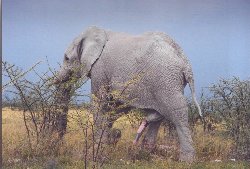 |
We drove a little farther and saw in
the road an empty potato chip bag some thoughtless cretin had thrown out his window. Dan
stopped to retrieve it and though it was dripping wet, assumed it was just dew-soaked and
tossed it into the back seat with Ty. We immediately noticed that the car was filled with
an incredibly powerful aroma, and quickly realized that our horny elephant friend had
'marked' the obtrusive piece of litter by peeing on it. For days afterward the car reeked
of 'eau d'elephant'.
Around noon we stopped to watch three
bulls frolicking about in a lake. When they came out of the water one of them became very
aggressive and again we were forced to beat a hasty retreat. Later in the day Ty went on a
night drive with a Parks Board Ranger. The ranger told him that six weeks earlier two
people had been killed by an enraged elephant. One of the fatalities was a tourist whose
car got stomped into spare parts; the other was a professional hunter sent out to put down
the same rogue bull.
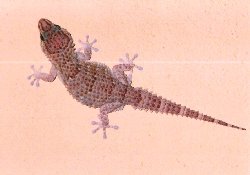 |
Lots of night noises. Buttonscale geckos live under
the eves and make an incredibly loud bark for such a small critter. Throughout the night
we were repeatedly awakened by screams of fighting baboons just outside the fence. |
Another long day driving north and
eastward from Manyane Camp at Pilanesburg to Kruger National Park; along the way passing
through lush avocado and citrus valleys dotted with picturesque villages of mud rondavels.
Though we had started driving just after dawn, we barely made it through the gates at
Punda Maria minutes before the 1830 closing time.
.
23 April 1998
Punda Maria to Sirheni. Drove to north
boundary of Kruger National Park and the Republic of South Africa, looking across the
crocodile-strewn Limpopo River to Mozambique on opposite shore. Many new birds, including
spectacular White-fronted Bee-eaters.
| We arrived at Sirheni to find the river dried-up .
. . unusual for this time of year. There remains a pool behind the dam with crocs and
snorting hippos. We prepared dinner on the braai at the forest's edge behind our bungalow,
complemented by one of Gielie's bottles of wine. All through dinner a toad high in the
rafters kept pooping on the table. After dark a Small Spotted Genet showed up and ate the
leftover chicken. |
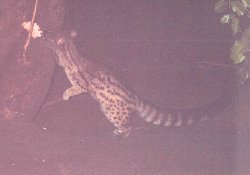 |
Next page up is the:
Fourth
Africa Page
dktdavis@aol.com










